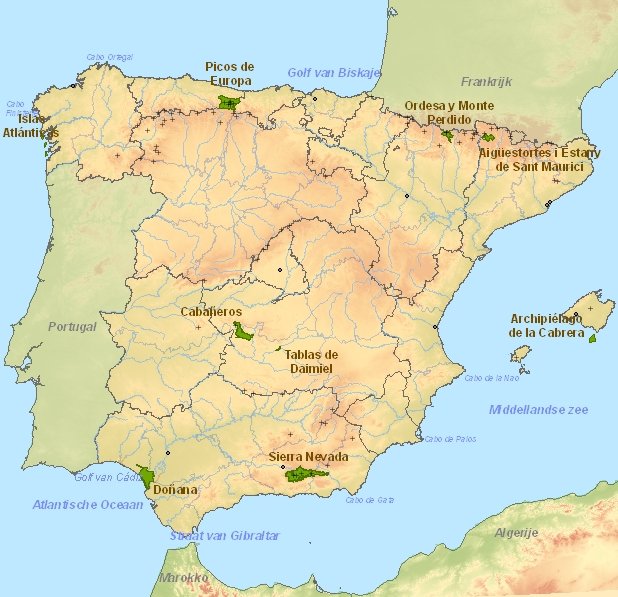All national parks in Spain (clickable map)

National parks
National park Aigüestortes i Estany de Sant Maurici (Catalonia)
: Park with more than 200 lakes with the impressive cliffs "Els Encantats" and the typical mountain (Aigüestortes). It is a real paradise for lovers of nature: lakes, streams, waterfalls, swamps, rugged mountains and lush forests of black pine, spruce, pine, birch and beech.2)
National park Picos de Europa (Asturias, León and Cantabria)
: Picos de Europa is the largest limestone formation of the Atlantic part of Europe with major karst processes, depressions up to 1000 meters and glacial erosion and the existence of very clear lakes.3)
National park Sierra Nevada (Andalusia)
: Reptiles, mammals (including the ibex), amphibians and birds are the beautiful flauna of the Sierra Nevada.4)
National park Tablas de Daimiel (Castile-La Mancha)
: River ecosystem (wetlands) with many waterbirds at the confluence of two rivers.5)
National park Teide (Canary Islands)
: This is the largest and oldest park in the Canary Islands with a special geological landscape in the form of spectacular volcanic cones and lava flows with beautiful colors and shapes.6)
National park Timanfaya (Canary Islands)
: The national landscape on the west side of Lanzarote (Canary Islands) is over 5100 hectares and consists of a rugged volcanic landscape dominated by the colors black (basalt lava) and red sand. The biological wealth consists of a large number of endemic plants and animals.7)
National park Archipiélago de Cabrera (Balearic Islands)
: This national Park is largely composed of sea area south of the island of Mallorca and the archipelago of Cabrera.8)
National park Cabañeros (Castile-La Mancha)
: This area in Montes de Toledo in the provinces of Ciudad Real and Toledo consists of 41,000 hectares of nature. In the area there is much wildlife such as eagles, vultures, black storks, deer, wild boar and deer. This area is even called the Spanish Serengeti. The area consists of Mediterranean forest (cork and holm oaks) with mountains between 800 and 1500 meters and wide valleys between them. Ideal as a nature-day trip from Toledo.9)
National park Caldera de Taburiente (Canary Islands)
: The almost 4700 hectare big National Park Caldera de Taburiente on the island of La Palma (Canary Islands) is characterized by an eight-kilometre wide caldera. It is the largest erosion crater in the world with a depth of 1500 meters. The highest point is the Roque de Muchachos (2426 m) and the visitor center is located at El Paso.10)
National park Doñana (Andalusia)
: The 54,000 hectare Doñana National Park in the provinces of Huelva and Seville on the Atlantic coast and the old mouth of the Guadalquivir River is one of the most important wetlands in Europe. It is a breeding and wintering area for thousands of birds (including Spanish imperial eagles) from Europe and Africa. The Iberian lynx can also be found here. The ecosystem in Doñana consists of beaches, dunes and swamps and gives the park a unique atmosphere. The area is very flat, the highest point is Loma del Chocolate with a height of 47 meters above sea level.11)
National park Garajonay (Canary Islands)
: This national park on La Gomera is 4000 hectares and is known for the laurel-forest vegetation (Lauri silva), geological monuments and special fauna. The laurel forests are remnants of the so-called tertiary flora, evergreen forests that exists in Europe in past times. It is one of the older natural forests in Europe. Special fauna consists of yellow wagtail, laurel-pigeon and geckos.12)
National park Islas Atlánticas de Galicia (Galicia)
: The Rias Baixas area in Galicia (provinces of Pontevedra and A Coruña) consisting of the islands (archipelagos) Cies, Sálvora, Ons, and Cortegada. The biggest part of this park is maritime in nature (7200 hectares), the land area (islands) is 1200 hectares. The area consists of rocks, scrub, dunes, beaches and a beautiful seafloor.13)
National park Monfraguë (Extremadura)
: Area in south-western Spain (Extremadura - Cáceres) north of Trujillo with an area of 18000 hectares. The area is only recently a national natural park and is particularly interesting for bird-lovers and nature admirers. The area consists of hills, forests (cork oak, holm oaks, wild olives), meadows and rocky areas.14)


